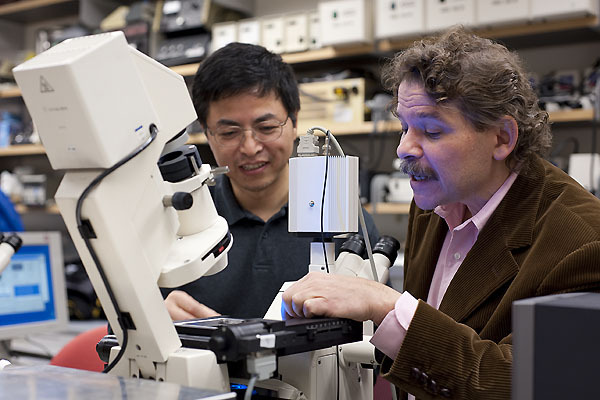Final Four brings together research powerhouses

Associate scientist Shiguo Zhou (left) and genetics and chemistry Professor David C. Schwartz look at one of the automated research microscopes used to optically map the DNA genome sequence of corn in 2009. They are among the UW–Madison researchers conducting more than $1 billion in research annually.
The university communities of UW–Madison, Duke, Kentucky and Michigan State may have basketball foremost on their minds this weekend, but year-round those minds are performing extraordinary research.
From pioneering touch screens and weather satellites that we all take for granted to discovering life-saving new medications in the most unusual places, all four top-tier research universities perform nearly $3 billion in research and development each year, making them economic engines for their states and the nation, now and into the future.
“Wisconsin is the proud home of world-changing innovations and discoveries,” says University of Wisconsin–Madison Chancellor Rebecca Blank. “Our top-ranked achievements on the basketball court are matched by top-ranked work in the classroom and in our research labs.”
“Behind the competition on the hardwood, university researchers go one-on-one with some of humanity’s toughest problems every day,” MSU President Lou Anna K. Simon says. “The same passion and tenacity that drive teams into the Final Four is also at work in our laboratories, classrooms and in our communities.”
“As our men’s basketball team unites the commonwealth we serve, so, too, does the work of our faculty, staff and students, today and in the future,” says University of Kentucky President Eli Capilouto.“A cornerstone of UK’s multi-faceted mission is our research in the humanities, hard sciences, liberal arts and health care that touch all aspects of life, from the cellular to the community level.”
“We are proud of our team and their great success this year, which only helps call more attention to the breakthroughs that occur every day at Duke in our understanding of the world around us,” says Duke President Richard H. Brodhead. “It’s like winning the national championship in medicine, technology, behavior, and culture, among others.”
Innovations in medicine
- Last week, UW–Madison unveiled an advance in the fight against Ebola — a whole virus vaccine shown to be effective in monkeys.
- About half of all prescription drugs in use today target a receptor on the surface of human cells that has been the life work of Duke’s Robert Lefkowitz, the 2013 Nobel Prize winner in chemistry.
- A Michigan State doctor has figured out how cerebral malaria kills children at a rate of one per minute around the world, a finding that is expected to lead to life-saving new treatments.
- Warfarin, a widely used blood-thinner for treating stroke and heart disease, grew out of a University of Wisconsin investigation into the mysterious death of a calf after it ate spoiled hay.
- Naloxone, a life-saving antidote to heroin overdose, is being developed into a fast-acting nasal spray at the University of Kentucky’s College of Pharmacy.
Innovations in physics and engineering
- The first space-based telescope was built by UW–Madison scientists, paving the way for the Hubble Space Telescope.
- University of Kentucky researcher Samuel Hurst developed the precursor to the screens used in the iPad and ATMs. It recognized single-touch gestures.
- MSU is home to the nation’s top program in nuclear physics, thanks in part to its new Facility for Rare Isotope Beams.
- Duke physicists are developing and commercializing a host of new ideas around the concept of metamaterials — engineered surfaces that can redirect light, sound and even physical stresses, leading to powerful new antennas and even a sort of “invisibility cloak.”
Final Four fever may spike every year, but federal support for this kind of world-changing work is on the wane — even as the number of highly trained researchers grows. Tightened budgets at the agencies that fund research and development means many of the kind of creative new ideas that lead to innovative discoveries never get a chance to prove their worth.
“There is no shortage of important unanswered research questions and the challenge we face is the need for adequate funding for research as well as for the faculty, staff and students who carry it out,” says Marsha Mailick, UW–Madison vice chancellor for research and graduate education.
As top seeds among U.S. research universities, Duke, Kentucky, Michigan State and UW–Madison are better prepared than most institutions to compete for public science funding. But increased competition for fewer grant dollars could do irreparable damage to one of the country’s best sources of technological innovation and economic momentum.
Learn More about the Final Four of research universities this weekend at #Final4Research
Tags: research, student life



